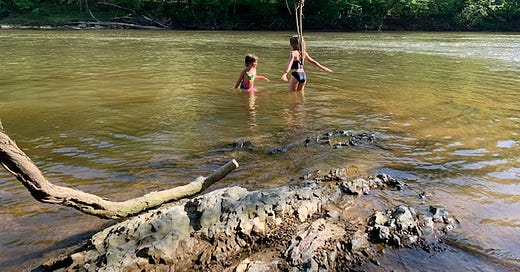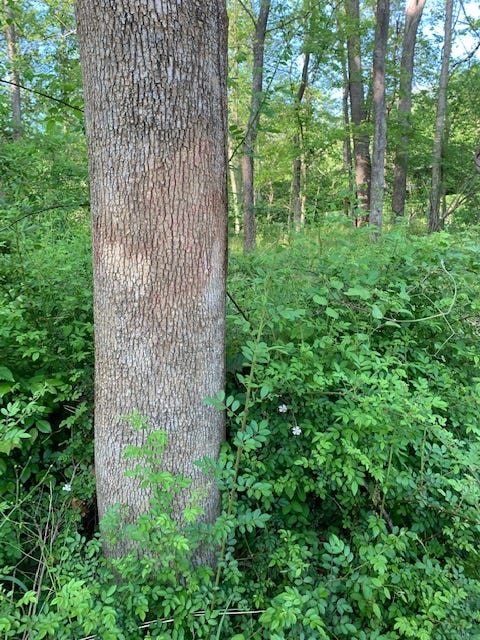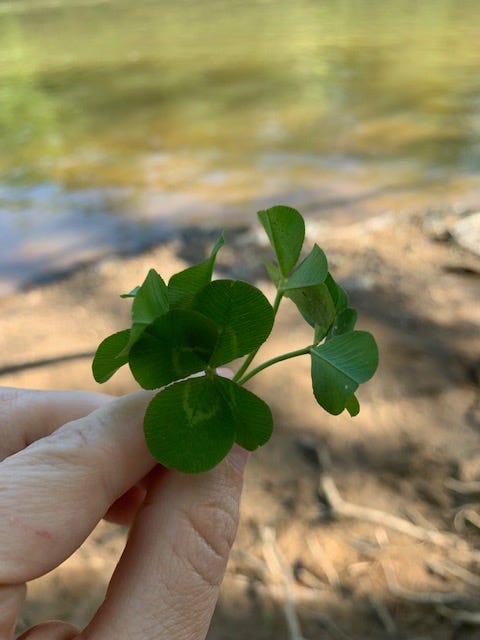We have two spots, close to our house, where we like to explore the Haw River. The first is private, an easement shared by my neighborhood. It’s pretty idyllic, looking out over a beautiful section of gentle rapids where the river is divided by a series of small, wild islands. A huge log washed up there a few years ago, perfect for sitting. Across the river, a massive pine tree holds a bald eagle nest, and this time of year you can watch them fledge. Once, after a full moon, Beatrice and I found a whole series of Luna moth wings (more than ten sets), following the moss-covered path we walk to this spot on the river.
The other place we like to go is technically private, but used like public land because it’s close to a small gravel parking lot. This is where we like to swim, because the bottom is sandy. There’s a rope swing, interesting rock formations, and (currently) a fallen tree being chewed apart by beavers. This is where we found the spiny softshell turtle the other day, and we also see cormorants, eagles, snakes, and dogs people bring out for exercise (once we saw a man in an inner tube, cradling a baby goat!). All kinds of people use this spot to launch kayaks, fish, picnic, barbecue, and swim, but it’s not crowded. You might see someone, and you might not.
Back in February, the girls and I were walking along the river at this spot, and we discovered that someone had painted a swastika on the tree that holds the rope swing. In the summer of 2021, one appeared under the bridge, where there’s also been some other (harmless) graffiti, and Richard painted over it. But this one was on a tree, right where people like to swim, extremely visible. As I wrote before, I didn’t want to paint over it, and I also didn’t want to call the police—I like that this is not a place where cops go, because cops are intimidating and carry guns. And technically, this is private land. None of us should be here, but like a lot of uninhabited rural places, especially water access places, it functions more like public land.
Bea and I took a wire grill brush and scrubbed the tree until you could no longer make out the swastika. Bea knows what a swastika is, knows that it’s a symbol of hate and persecution, but symbols of this sort are still kind of abstract to her. What bothered her the most was that someone had spray-painted a tree. What bothered me the most was that someone who would paint a swastika was using the same river spot where my children and my neighbors swim, picnic, fish, and relax. I was relieved, after a vigorous scrubbing and a few heavy rains that covered the base of the tree, then receded, that you really couldn’t see it at all.
Just before our trip to Alabama, we saw another one, this time up the hill, as if the person thought that perhaps the floods had washed away the first one. This one sat even heavier with me because it meant that the person had returned, and was maybe using this spot regularly.
Now, I’m not afraid that I’m endangering my kids when we go to the river—I don’t think anyone will attack us or anyone else. I’m more afraid that Harriet will kick up her heels and go floating down to Bynum in her life vest. But I don’t want to look at swastikas while I swim, and I don’t want my immigrant neighbors, my Jewish neighbors, or my Black neighbors to see swastikas and feel afraid either.
This spot, which is private land, also functions as a kind of public square, where people who like the water come together. The girls and I could easily go back to the more-private space that I share with my close neighbors. But we’d miss out on meeting people, like our new friend George and his two Labradors. And we wouldn’t see what happens with the beaver tree! And we would have missed spotting that cool softshell turtle.
So our only choice, it seems, is vigilance and a grill brush. I knew to dip my brush in river water first, then apply pressure as I worked in short sections to flake away just the top layer of ugly red paint. I scrubbed away that second graffiti in a matter of minutes this time, and the tree was (almost) as good as new.
But I’ve been thinking about it ever since, especially after the news this week that Elon Musk bought Twitter. I don’t love Twitter, though I have an account and go there sometimes if I’m bored or if Richard points out something funny. I should probably go there more often, since I’m a writer and it’s a tool for promoting your work. It doesn’t do good things for my brain, so I don’t. But other people do—hundreds of millions of people, from all over the world. It’s not well-policed now, but it’s somewhat policed against hate speech and abuse.
This week Josh Marshall wrote, in Talking Points Memo, about the falsity of Musk’s claim that Twitter is the “de facto town square”:
Anything that bloodies up the idea that these company spaces are the public square is thus a good thing. If Musk really is the Lex Luthor comic book villain people make him out to be (and which he really may be) I’m ready to see him treat Twitter like his own maniacal toy because he bought it and therefore he can. That’s good because it will be more clear that Twitter is not the public square. It’s a company impersonating the public square that a nasty person can buy. If people flee to other sites or find ways to operate around his malevolence I’m ready for that. That’s why my reaction to this is just as much “let it burn” as “oh no.” Probably a bit more so.
I don’t think it’s good at all that Musk has purchased Twitter. But the real threats to civic life aren’t content moderation. It’s private companies impersonating the public square in our civic life. Things that break down that deception are not a bad thing.
It reminded me of this river spot. It’s also private, but it’s used by so many people as access to something they don’t have otherwise (and decreased access to waterways because of private ownership is another big issue). I get what Marshall is saying—Jack Dorsey, Mark Zuckerberg, and Elon Musk are all rotten billionaires who are controlling too much. But journalists use Twitter to source information and quotes. People use Twitter to raise money, to draw attention to important causes and injustice, and to see funny animal memes. I suppose some people even use it to relax (!).
I think it’s better to keep Nazi expression out of every space where people congregate—to say, nope, you can’t do that here, there’s a history there and we’re not repeating it. It makes me think of this Maya Angelou quote, emblazoned on the side of the Legacy Museum and in murals around Montgomery:
History, despite its wrenching pain, cannot be unlived; but if faced with courage, need not be lived again.
Part of facing history with courage, it seems to me, is education—studying, acknowledging, and talking about the past. Another part is vigilance, recognizing that some of us are more vulnerable to hateful attacks, but we’re all vulnerable to some degree. There’s nothing I can do about Twitter or Facebook. So I suppose what I’m saying that Bea and Richard and I are content moderating at the river, and we’re not going anywhere.
How about you, Frog Troublers? Did you have to stay vigilant this week? Looking again at that photo I think I’ll take my grill brush with me to the river today. But nature also helps—in another few weeks, you won’t be able to see it. And eventually, the tree’s outer bark will be renewed. I’m not sure how long that takes—a good reminder there’s always more to learn.







my girls with their grill brushes are super sheroes!!!!
I think your moderating at the river is the most impactful way to deal with this despicably hateful graffiti. Keep it a safe safe for those who otherwise not have access and build a community with those people for your children and their children. You are a very wise person in my opinion. The best decisions are made with heart and a little elbow grease to protect the space is a wonderful example for your children, and all of us who read FTT. My love to all! I am glad that you have recovered from COVID and everyone else is the family stayed healthy.